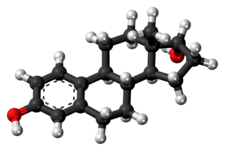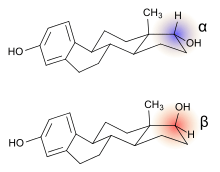Alfatradiol
 | |
 | |
| Clinical data | |
|---|---|
| Trade names | Avicis, Avixis, Ell-Cranell Alpha, Pantostin |
| Synonyms | 17α-Estradiol; 17-Epiestradiol; MX-4509; Estra-1,3,5(10)-triene-3,17α-diol; β-Estradiol (obsolete, misleading)[1] |
| AHFS/Drugs.com | International Drug Names |
| Pregnancy category |
|
| Routes of administration | Topical |
| Drug class | Estrogen; 5α-Reductase inhibitor |
| ATC code |
|
| Legal status | |
| Legal status |
|
| Identifiers | |
| |
| CAS Number | |
| PubChem CID | |
| ChemSpider | |
| UNII | |
| ChEBI | |
| ChEMBL | |
| ECHA InfoCard |
100.000.322 |
| Chemical and physical data | |
| Formula | C18H24O2 |
| Molar mass | 272.388 g/mol |
| 3D model (JSmol) | |
| |
| |
| (verify) | |
Alfatradiol, also known as 17α-estradiol and sold under the brand names Avicis, Avixis, Ell-Cranell Alpha, and Pantostin, is a weak estrogen and a 5α-reductase inhibitor which is used as a topical medication in the treatment of androgenic alopecia (pattern hair loss) in men and women.[1][2][3][4] It is a stereoisomer of the endogenous steroid hormone and estrogen 17β-estradiol (or simply estradiol).[1]
Medical uses
Alfatradiol is used in form of an ethanolic solution for topical application on the scalp. Similarly to other drugs against alopecia, topical or oral, it has to be applied continuously to prevent further hair loss.[5] Regrowth of hair that was already lost is only possible to a limited extent. In general, advanced alopecia does not respond well to medical treatment, which has historically been thought to be a consequence of the hair roots being lost.[6]
A university-led study (including several authors who are advisors to companies such as Pfizer) in 103 women comparing alfatradiol to minoxidil, another topical hair loss treatment, found the latter to be more effective. In contrast to minoxidil, alfatradiol did not result in an increase of hair density or thickness, but only in slowing down or stabilization of hair loss in this study.[7] In an earlier study, no systemic side effects were noted, and 17α-estradiol was found to reduce androgenic hair loss, though it was not effective at growing new hair.[8]
Other efforts of alfatradiol had been directed at neurodegenerative diseases including Parkinson's.[9]
Other hair loss medications include ketoconazole, finasteride, and dutasteride.
Contraindications
Nothing is known about the use of alfatradiol during pregnancy or lactation, or in patients under 18 years of age. The package leaflet recommends against using it under these circumstances.[10]
Side effects
Local burning or itching is not an effect of alfatradiol, but of the ethanol in the solvent. The solution can stimulate sebum production.[10]
Pharmacology
Pharmacodynamics

Alfatradiol (17α-estradiol) is distinguished from estradiol (17β-estradiol), the predominant sex hormone in females, only by the stereochemistry of the carbon atom 17. In contrast to 17β-estradiol, 17α-estradiol, while it still binds to the estrogen receptor, has less or no feminizing estrogenic activity depending on its dosage and the tissue it is affecting.[11] Alfatradiol acts as an inhibitor of the enzyme 5α-reductase, which is responsible for the activation of testosterone to dihydrotestosterone, and which plays a role in regulating hair growth.[5] 17α-Estradiol has been studied as a therapeutic with potential to treat Alzheimer's and Parkinson's disease and other patients suffering from neurodegenerative diseases.[12] 17α-Estradiol (as the sodium salt of its sulfated form) is a minor component (<10%) of hormone replacement products (such as conjugated estrogens, brand name Premarin), which have been studied and/or marketed in women and men since the 1930s. A survey of the effects of various forms of 17α-estradiol in humans on biochemical parameters, efficacy, estrogenicity, metabolism, safety, and tolerability has been published.[13]
Alfatradiol binds to the ERα and ERβ with 58% and 11% of the relative binding affinity of 17β-estradiol.[14] However, it has 100-fold lower estrogenic activity relative to estradiol,[15] which may in part be due to differences in the intrinsic activity of the two compounds. On the other hand, alfatradiol has been found to bind to and activate the brain-expressed ER-X with a greater potency than estradiol, indicating that it may be the predominant endogenous ligand for the receptor.[16]
| Compound | PR | AR | ER | GR | MR | SHBG | CBG | ||
|---|---|---|---|---|---|---|---|---|---|
| Estradiol | 2.6 | 7.9 | 100 | 0.6 | 0.13 | 8.7 | <0.1 | ||
| Alfatradiol | <1 | <1 | 15 | <1 | <1 | ? | ? | ||
| Estriol | <1 | <1 | 15 | <1 | <1 | ? | ? | ||
| 17α-Epiestriol | <1 | <1 | 31 | <1 | <1 | ? | ? | ||
| Values are percentages (%). Reference ligands (100%) were progesterone for the PR, testosterone for the AR, E2 for the ER, DEXA for the GR, aldosterone for the MR, DHT for SHBG, and cortisol for CBG. | |||||||||
Society and culture
Generic names
Alfatradiol is the generic name of the drug and its INN.[2] It is also known as 17α-estradiol.[1]
Brand names
Alfatradiol is marketed under the brand names Avicis, Avixis, Ell-Cranell Alpha, and Pantostin.[2]
Availability
Alfatradiol is available in Germany and several Latin American countries, including Argentina, Brazil, and Mexico.
Research
Alfatradiol administered systemically improved metabolic function, reduced insulin resistance, decreased intra-abdominal fat, and decreased inflammation in old male mice without inducing feminization, suggesting potential usefulness in the treatment of type 2 diabetes.[21]
See also
- Alfatradiol/dexamethasone (Ell-Cranell Dexa)
- Estradiol 17α-dehydrogenase
- List of estrogens
References
- 1 2 3 4 J. Elks (14 November 2014). The Dictionary of Drugs: Chemical Data: Chemical Data, Structures and Bibliographies. Springer. pp. 897–. ISBN 978-1-4757-2085-3.
- 1 2 3 "Alfatradiol". Drugs.com International.
- ↑ Berger A, Wachter H, eds. (1998). Hunnius Pharmazeutisches Wörterbuch (in German) (8 ed.). Walter de Gruyter Verlag. p. 486. ISBN 978-3-11-015793-2.
- ↑ "Recommended International Nonproprietary Names (rec. Inn): List 46". WHO Drug Information. 15 (3&4). 2001.
- 1 2 Mutschler E, Geisslinger G, Kroemer HK, Schäfer-Korting M (2001). Arzneimittelwirkungen (in German) (8 ed.). Stuttgart: Wissenschaftliche Verlagsgesellschaft. p. 453. ISBN 978-3-8047-1763-3.
- ↑ Jasek W, ed. (2007). Austria-Codex (in German). 4 (2007/2008 ed.). Vienna: Österreichischer Apothekerverlag. p. 9673. ISBN 978-3-85200-181-4.
- ↑ Blume-Peytavi U, Kunte C, Krisp A, Garcia Bartels N, Ellwanger U, Hoffmann R (May 2007). "Comparison of the efficacy and safety of topical minoxidil and topical alfatradiol in the treatment of androgenetic alopecia in women". Journal Der Deutschen Dermatologischen Gesellschaft = Journal of the German Society of Dermatology. 5 (5): 391–5. doi:10.1111/j.1610-0387.2007.06295.x. PMID 17451383.
- ↑ Orfanos CE, Vogels L (1980). "[Local therapy of androgenetic alopecia with 17 alpha-estradiol. A controlled, randomized double-blind study (author's transl)]". Dermatologica (in German). 161 (2): 124–32. PMID 7398983.
- ↑ "Alfatradiol". Adis Insight.
- 1 2 Dootz H, ed. (2005). Rote Liste (in German) (2005 ed.). Aulendorf: Editio Cantor Verlag. 32 369. ISBN 978-3-87193-306-6.
- ↑ Moos WH, Dykens JA, Howell N (2008). "17α-Estradiol: A Less-Feminizing Estrogen". Drug Dev. Res. 69 (4): 177–184. doi:10.1002/ddr.20244.
- ↑ Dykens JA, Moos WH, Howell N (June 2005). "Development of 17alpha-estradiol as a neuroprotective therapeutic agent: rationale and results from a phase I clinical study". Annals of the New York Academy of Sciences. 1052: 116–35. doi:10.1196/annals.1347.008. PMID 16024755.
- ↑ Moos WH, Dykens JA, Nohynek D, Rubinchik E, Howell N (2009). "Review of the Effects of 17α-Estradiol in Humans: A Less Feminizing Estrogen with Neuroprotective Potential". Drug Dev. Res. 70: 1–21. doi:10.1002/ddr.20284.
- ↑ Kuiper GG, Carlsson B, Grandien K, Enmark E, Häggblad J, Nilsson S, Gustafsson JA (March 1997). "Comparison of the ligand binding specificity and transcript tissue distribution of estrogen receptors alpha and beta". Endocrinology. 138 (3): 863–70. doi:10.1210/endo.138.3.4979. PMID 9048584.
- ↑ Trüeb RM, Lee W (13 February 2014). Male Alopecia: Guide to Successful Management. Springer Science & Business Media. pp. 93–. ISBN 978-3-319-03233-7.
- ↑ Toran-Allerand CD, Tinnikov AA, Singh RJ, Nethrapalli IS (September 2005). "17alpha-estradiol: a brain-active estrogen?". Endocrinology. 146 (9): 3843–50. doi:10.1210/en.2004-1616. PMID 15947006.
- ↑ Raynaud JP, Ojasoo T, Bouton MM, Philibert D (1979). "Receptor Binding as a Tool in the Development of New Bioactive Steroids". In Ariëns EJ. Drug Design. pp. 169–214. doi:10.1016/B978-0-12-060308-4.50010-X. ISBN 9781483216102.
- ↑ Ojasoo T, Raynaud JP (November 1978). "Unique steroid congeners for receptor studies". Cancer Research. 38 (11 Pt 2): 4186–98. PMID 359134.
- ↑ Ojasoo T, Delettré J, Mornon JP, Turpin-VanDycke C, Raynaud JP (1987). "Towards the mapping of the progesterone and androgen receptors". Journal of Steroid Biochemistry. 27 (1–3): 255–69. doi:10.1016/0022-4731(87)90317-7. PMID 3695484.
- ↑ Raynaud JP, Bouton MM, Moguilewsky M, Ojasoo T, Philibert D, Beck G, Labrie F, Mornon JP (January 1980). "Steroid hormone receptors and pharmacology". Journal of Steroid Biochemistry. 12: 143–57. doi:10.1016/0022-4731(80)90264-2. PMID 7421203.
- ↑ Stout MB, Steyn FJ, Jurczak MJ, Camporez JG, Zhu Y, Hawse JR, et al. (January 2017). "17α-Estradiol Alleviates Age-related Metabolic and Inflammatory Dysfunction in Male Mice Without Inducing Feminization". The Journals of Gerontology. Series A, Biological Sciences and Medical Sciences. 72 (1): 3–15. doi:10.1093/gerona/glv309. PMC 5155656. PMID 26809497.